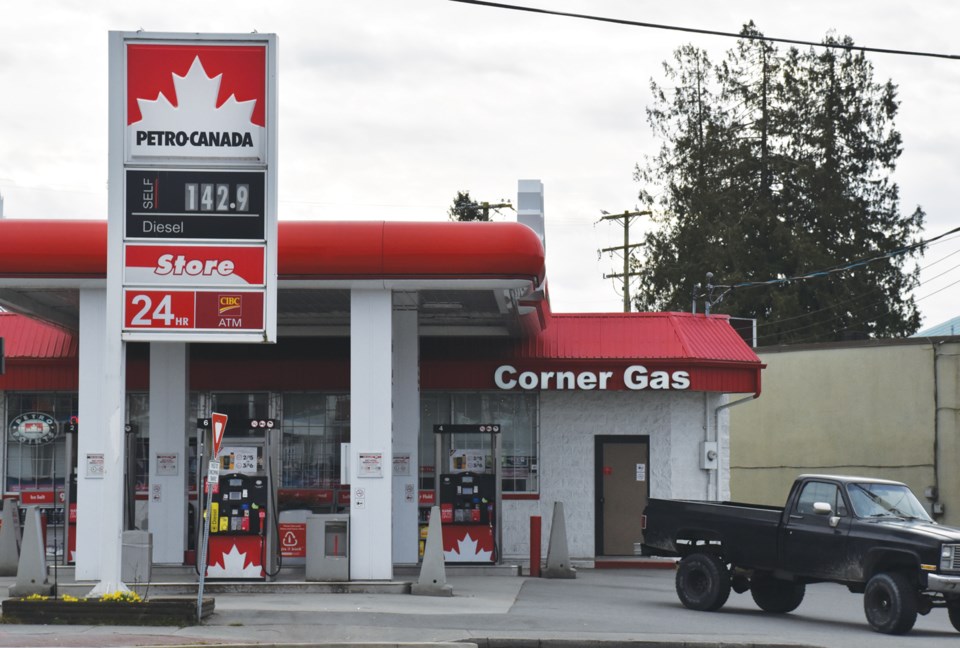Isolation may be a problem for some on the Sunshine Coast, but it’s helping keep gas prices lower than across Howe Sound, where Metro Vancouver motorists are fuelling up for as much as 154.9 cents per litre – the most expensive price in North America.
Gas prices have been soaring across the Lower Mainland lately, and the hike will march into spring, said Dan McTeague, senior petroleum analyst at GasBuddy, a crowd-sourcing company that monitors and analyzes fuel prices. By mid-April, “we could see a scenario that brings us closer to $1.60 for Metro Vancouver,” he said.
As of March 19, the average price of gas for the Sunshine Coast was $1.385 per litre, on par with the provincial average, and up 17 cents from this time last year.
McTeague said the Coast is being spared Vancouver’s extreme prices for two reasons: it’s not subject to the TransLink transit tax of 11.5 cents per litre, and gas stations don’t charge the full margin of 12 cents per litre allowed in Vancouver.
“Always assume there’s a 12 cent advantage or more for the Sunshine Coast, no matter what the price is in Vancouver,” he said.
With no pipeline, rails or refineries, gas is shipped from Vancouver via ferry. A truck can carry as much as 80,000 litres and top up two or three gas stations, said McTeague, and the extra transportation cost may add two or three cents to the per-litre wholesale price.
Those added cents are still fewer than what’s needed to run a station in Metro Vancouver. “They often charge 12 cents a litre as a retail margin, whereas here, if you’re looking at $1.37 to $1.42 per litre, that margin is more like eight to 12 cents, so somewhere in between, and that’s good enough for many stations to survive. They don’t have the large overhead they might have in larger cities.”
McTeague chalked up the recent price increases to a refinery outage in Burnaby, and because two of four refineries in Washington state are closing temporarily. Another pipeline called the Olympic is also shutting down for maintenance. “That’s put a bit of a crimp in supply in an already sensitive time,” he said.
Gas prices will also stay high as retailers switch over to a summer fuel blend, which doesn’t evaporate in the heat at the same rate, but which costs more money. Added to that is a weak Canadian dollar, and the incoming carbon tax increase set to take effect April 1.
A spat between B.C. and Alberta governments over the Trans Mountain pipeline expansion has also fuelled uncertainty about prices at the pump. During Alberta Premier Rachel Notley’s March 8 throne speech, she suggested her government could change legislation to control the flow of gas and oil exports, including to B.C. And if that ever were to happen, “it would be catastrophic,” McTeague said. At least half the gas coming to southwest B.C. comes from the Trans Mountain pipeline. “Vancouver would go from $1.54 to over $2 a litre instantly. But that’s worst-case scenario. I don’t really see that unfolding or being in anyone’s interest,” he said. “But it does speak to the fragile nature of gasoline supply in the Lower Mainland, which is chronically short.”
Meanwhile, consumers are feeling the chronic pain of under-supply.
“I find myself spending at least $20 to $40 extra a week,” said Randy Hollett as he fuelled his pickup in Gibsons. “I just got back from Newfoundland, too, and down there it’s $1.12, so when I came up here I was 30 seconds at the pump and done.” Still, he said he hasn’t needed to adjust his budget.
Not so for Ian Thomson. “I’m on disability and it sucks.” He relies on his car for shopping and because of his injury, he can’t use public transit. And he drives to Sechelt from Gibsons for doctor appointments. For Thomson, spending more on gas has meant spending less on basics. “I’ve got to shorten my food. Less food,” he said. “More Kraft Dinner, more beans.”



